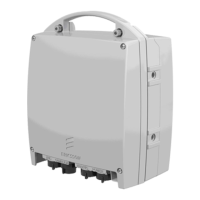MINI-LINK BAS 4-6
Technical Description EN/LZB 111 0542 P2B
4.3 CE Services
MINI-LINK BAS system supports Synchronous and plesiochronus,
unstructured E1/T1 service. Unstructured service can be used to
support any framed or unframed E1/T1 structure.
Unstructured CE end-user services are provided in MINI-LINK BAS
through the E1 and T1 interfaces at the NU.
CE Services are supported via ATM PVCs. In the CE case, however, a
CBR service category is used to ensure low cell loss ratio, low cell
delay and low cell delay variation.
The mapping of the CE services in ATM cells is done in MINI-LINK
BAS according to the ATM forum CE service inter-operability
Specification (AF-VTOA-0078.000), ITU-363 and ETSI ETS 300
363.
The unstructured circuit transport allows transport of any framed or
unframed E1/ T1 services over MINI-LINK BAS. It does not however
enable the operating company to monitor the performance of the
framed E1/T1 services. Data traffic and embedded facilities, signalling
and maintenance information, are transparently transported.
Bits of E1/T1 interfaces are mapped into ATM cell payload using the
AAL-1/Unstructured Data Transfer (UDT) mode adaptation layer.
The synchronous or plesiochronous modes of operation are selectable
per port basis via the EM.
Synchronous mode applies when the E1/T1 interfaces connected by
the CE connection are synchronised to a common primary reference
clock used also by the MINI-LINK BAS.
Plesiochronous mode is used when:
• the E1/T1 interfaces connected by the CE connection are not
synchronised to the same primary reference clock,
or
• if they use a common clock different from the one adopted by the
MINI-LINK BAS, for example, a Private Automatic Branch
Exchange (PABX) connected to a Plain Old Telephone Service
(POTS) carrier not providing the reference clock to the
MINI-LINK BAS.
In the plesiochronous case the receiving CE function rebuild the
originating clock from the receiving cell interarrival timing. The
protocol stack for the transparent transport of E1/T1 bit stream is
shown in Figure 4-4.
Note that the AAL-1 protocol originated by a FlexNU can be
terminated either in a CE board housed in the MINI-LINK BAS, R-
AAS or CE-AAS, or in any external CE equipment compliant with the
CE service inter-operability Specification or ATMF ITU/ETSI
relevant standards.

